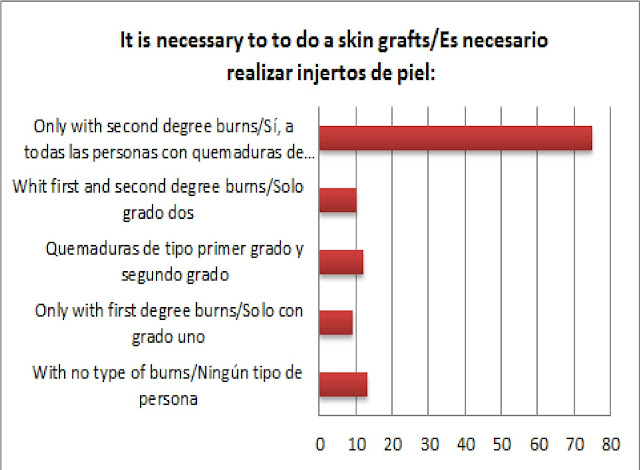Vicente interviews his teacher of English/Vicente entrevista a su profesor de inglés (English)
Entrevista a Jordan, un profesor americano/Interview with an american teacher (English)
Interview with spanish nurse/ Entrevista a una enfermera (Spanish)
Interview with a parent/ Entrevista a un padre de familia (Spanish)
Interview with student of Mater in Secondary Education teacher/ Entrevista a una alumna del Máster de secundaria (Spanish)
17 mar 2013
15 mar 2013
17. It is necessary to to do a skin grafts/Es necesario hacer injertos de piel
En esta pregunta la respuesta depende de la persona afectada pero en general la respuesta correcta es la e), las quemaduras de tercer grado suelen necesitar injertos de piel. Aciertan un 63% de los encuestados.
In this question the response depends on the affected person but in general the correct response is it e), the burns of the third degree are in the habit of needing leather grafts. They succeed 63 % of the polled ones.
14 mar 2013
16.What is it so dangerous to expose an area already burned to a new source of heat or cool?/¿Por qué es peligroso exponer una quemadura a una fuente de calor?
La mitad de los encuestados aciertan la respuesta correcta, las zonas previamente quemadas corren más riesgo de volverse a quemar.
The half of the polled ones they succeed the correct response, the before burnt zones traverse more risk of returning to be hot.
15.Beliefs about sunburn/Creencias sobre las quemaduras solares
Un 13% de los encuestados creen erróneamente que los días nublados no es necesario protegerse de la radiación solar.
13 % of the polled ones believes erroneously that the cloudy days it is not necessary to be protected from the solar radiation.
13 mar 2013
14.What to do with a person who is receiving an electric shock?/¿Qué hacer cuando una persona está recibiendo una descarga eléctrica?
13.What to do after a frostbite?/¿Qué hacer ante una quemadura por congelación?
12 mar 2013
12.What to do after a burn by a heat source?/¿Qué hacer ante una quemadura por fuente de calor?
Acierto numeroso (49%) pero no mayoritario, observamos que falta información sobre cómo actuar ante el tipo de quemadura más habitual y reconocido por todo.
Numerous success (49 %) but not majority, we observe that information is absent about how acting before the type of burn most habitual and recognized by all.
11. List four ways to prevent burns/Escribe cuatro maneras de prevenir quemaduras
El fuego y el sol siguen siendo los factores más reconocidos como causantes de quemadura, ambos suman un 46%.
The fire and the Sun continue being the factors most recognized like causative of burn, both add 46 %.
10.How is a burn produced?/¿Cómo se produce una quemadura?
A medida que avanza el cuestionario se producen más aciertos en la respuesta correcta, supongo que es por la lectura de las preguntas, en la pregunta un 89% de las personas aciertan cómo se produce una quemadura, cuando en las primeras preguntas no habían respondido bien.
As it advances the questionnaire more successes take place in the correct response, I suppose that it is for the reading of the questions, in the question 89 % of the persons succeeds how a burn takes place, when in the first questions they had not answered well.
Suscribirse a:
Entradas (Atom)






